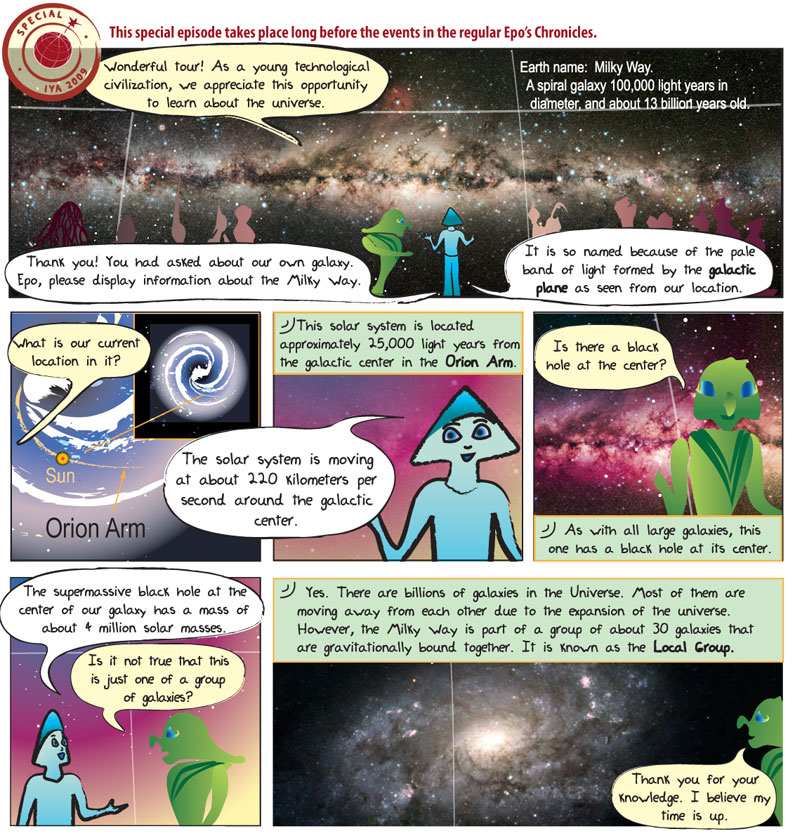
Comic Transcript
Panel 1.
Ambassador: Wonderful tour! As a young technological civilization, we appreciate this opportunity to learn about the Universe.
Alkina: Thank you! You had asked about our own galaxy. Epo, please display information about the Milky Way. It is so named because of the pale band of light formed by the galactic plane as seen from our location.
Panel 2.
Ambassador: What is our current location in it?
Panel 3.
Epo: This solar system is located approximately 25,000 light years from the galactic center in the Orion Arm.
Alkina: The solar system is moving at about 220 kilometers per second around the galactic center.
Panel 4.
Ambassador: Is there a black hole at the center?
Epo: As with all large galaxies, this one has a black hole at its center.
Panel 5.
Alkina: The supermassive black hole at the center of our galaxy has a mass of about 4 million solar masses.
Ambassador: Is it not true that this is just one of a group of galaxies?
Panel 6.
Epo: Yes. There are billions of galaxies in the Universe. Most of them are moving away from each other due to the expansion of the universe. However, the Milky Way is part of a group of about 30 galaxies that are gravitationally bound together. It is known as the Local Group.
Ambassador: Thank you for your knowledge. I believe my time is up.
What does it mean?
Galactic plane – contains most of the luminous matter. Most of the matter in the galaxy is dark, and most of the dark matter is located in the galactic halo.
Orion Arm – is one of the spiral arms of the Milky Way galaxy and it is in this region of the galaxy where our solar system resides.
Local Group – is the name given to the group of galaxies of which the Milky Way is a member.
Is that all?
Fact Sheet: Milky Way
 Mass: 5.8 x1011 Solar masses.
Mass: 5.8 x1011 Solar masses.
Diameter: 100,000 Light Years.
Age: Approximately 13 billion years.
Number of stars: About 200 to 400 billion.
More information:
The age of our galaxy is determined by the oldest observable star in it, which is about 13 billion years. This makes the Milky Way almost as old as the universe itself. It is a fairly large spiral galaxy with three main components:
- the central bulge, at the very center of which is a supermassive black hole,
- the disk, in which the majority of stars, including the Sun, reside. The disk also contains gas and dust, and as a result, the sites of new star formation,
- and the halo, which surrounds the Galaxy. The halo contains very old stars as well as most of the dark matter that comprises the majority of the mass of the Galaxy.
Because we live inside the Milky Way we do not have direct images of the entire galaxy as seen from outside. After all, our farthest spacecraft have only reached the edge of the solar system. However, we can get an idea of what our galaxy looks like by viewing other galaxies, some of which have a similar structure to our own.
Multi-wave Milky Way – What the plane of the galaxy looks like when viewed in different wavelengths of light.
